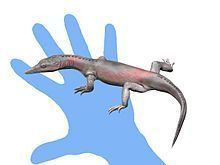Phylum Chordata | Class Reptilia Rank Genus | |
 | ||
Similar | ||
Lazarussuchus (meaning "Lazarus's crocodile") is a genus of basal choristodere, a type of amphibious reptile, known from France, Germany, and the Czech Republic. Fossils have been found in Late Paleocene, Late Oligocene, and Early Miocene deposit, meaning that the genus lasted about 40 million years. Two species have been named: the type species L. inexpectatus ("unexpected") (Hecht, 1992) from the late Oligocene of France and Germany and L. dvoraki (for Zdeněk Dvořák) from the early Miocene of the Czech Republic. It was not a large animal; the skull of L. inexpectatus was only about 4.53 centimeters long (1.78 in). A complete specimen of Lazarussuchus with preserved soft tissue was found from the Late Paleocene of France, but has not been assigned to a species.
Age and relationships
Lazarussuchus is the youngest member of the group Choristodera and the only choristodere to have lived after the Eocene. Choristoderes were once thought to have gone extinct at the start of the Eocene, possibly due to climatic changes happening at this time, known as the Paleocene-Eocene Thermal Maximum. The first known fossils of Lazarussuchus came from the Late Oligocene, meaning that it extended the fossil range of Choristodera by several million years. At the time of its discovery Lazarussuchus was considered an example of the Lazarus effect because its "unexpected" presence followed a long gap in the choristodere fossil record. However, older specimens of Lazarussuchus have been found that extend its fossil range to before the Eocene, closing the apparent gap in the record.
Lazarussuchus has been interpreted as the most basal member of Choristodera, meaning that its lineage must have been the earliest to branch off from the group. Since the first definitive choristoderes appear in the Middle Jurassic, the lineage represented by Lazarussuchus must have extended at least as far back as the Middle Jurassic. This implies a very long ghost lineage of choristoderes spanning at least 100 million years in which no fossils are currently known. The Lazarussuchus lineage may have been able to survive for such a long period of time and outlast all other choristodere lineages because they were small in size and had generalized, lizard-like body forms that enabled them to cope with environmental changes. However, a more recent study places Cteniogenys, the oldest known choristodere, as the most basal member of the group and has Lazarussuchus in a more derived position within a clade of small-bodied choristoderes known mostly from the Early Cretaceous. This position significantly shortens the ghost lineage of Lazarussuchus, although there is still a gap between the disappearance of small-bodied, lizard-like choristoderes at the end of the Early Cretaceous and their reappearance in the form of Lazarussuchus in the Paleocene. Possible lizard-like choristoderes have been found in Late Cretaceous North American deposits, although their remains are very fragmentary.
